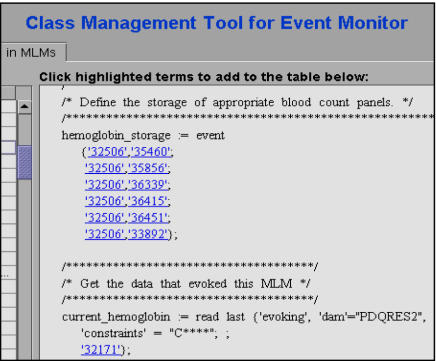Introduction.
Arden Syntax for Medical Logic Module (MLM)1 was designed for writing and sharing task-specific health knowledge in 1989. Several researchers have developed frameworks to improve the sharability and adaptability of Arden Syntax MLMs, an issue known as “curly braces” problem. Karadimas et al proposed an Arden Syntax MLM-based decision support system that uses an object oriented model and the dynamic linking features of the Java platform.2 Peleg et al proposed creating a Guideline Expression Language (GEL) based on Arden Syntax’s logic grammar.3 The New York Presbyterian Hospital (NYPH) has a collection of about 200 MLMs. In a process of adapting the current MLMs for an object-oriented event monitor, we identified two problems that may influence the “curly braces” one: (1) the query expressions within the curly braces of Arden Syntax used in our institution are cryptic to the physicians, institutional dependent and written ineffectively (unpublished results), and (2) the events are coded individually within a curly braces, resulting sometimes in a large number of events – up to 200. (Figure 1)
Figure 1.
Partial view of an MLM at NYPH
Methods.
Arden Syntax MLMs from the Columbia Presbyterian Medical Center were loaded in a visualization tool described elsewhere4. These MLMs contained Medical Entity Dictionary (MED) codes within the curly braces. As a first step to improve sharability and readability of Arden Syntax MLMs in our institution, we replaced multiple MED codes within the curly brace with a class-based representation. We used the visualization tool for better understanding of the classes. Classes were selected based on how well they represented the events in the curly braces. This process generated classed-based Arden Syntax MLMs.
In order to clarify the specific meaning of the query within the curly brace of an Arden Syntax MLM, we rewrote the institutional dependent query expression into a pseudo code. Then, the pseudo code was translated into the object-oriented expressions using the Java programming language.
Results.
Several Arden Syntax MLMs maintained at Columbia Presbyterian Medical Center were tested. For each MLM tested, we found the class(es) that represented the individual MED codes within the curly brace. If a MED class was not found, one was suggested. The translation from an institutional-based query inside of the curly brace into the object-oriented expression of Java was also achieved.
Conclusions.
A class-based representation can describe the events in a curly brace in a concise and effective way. The query expression within the curly braces of the MLMs was replaced by the Java method successfully. We believe that the Java methods can be reused within the MLMs. The suggested approach seems to be feasible to improve the current problems of the Arden Syntax in our institution. Further studies need to be conducted to identify if this methodology can be applied to all possible MLMs within our institution and perhaps others.
Acknowledgments
The authors thank Ying Tao for his support. This work was conducted under the 528753/PO P417322 grant from NASA/UVC.
References
- 1.Hripcsak G, et al. Rationale for the Arden Syntax. Comp Bio Research. 1994;27(4):291–324. doi: 10.1006/cbmr.1994.1023. [DOI] [PubMed] [Google Scholar]
- 2.Karadimas H, et al. Arden/J: An Architecture for MLM Execution on the Java Platform. JAMIA. 2002;9(4):359–368. doi: 10.1197/jamia.M0985. [DOI] [PMC free article] [PubMed] [Google Scholar]
- 3.Peleg, M., Ogunyemi, O., et al., Using Features of Arden Syntax with Object-Oriented Medical Data Models for Guideline Modeling. In: AMIA Symp. 2001. p 523–527. [PMC free article] [PubMed]
- 4.Tao Y, Mendonça EA, Lussier YA. A “systematics” tool for medical terminologies. Submitted to AMIA 2003 Fall Symp. [PMC free article] [PubMed]



